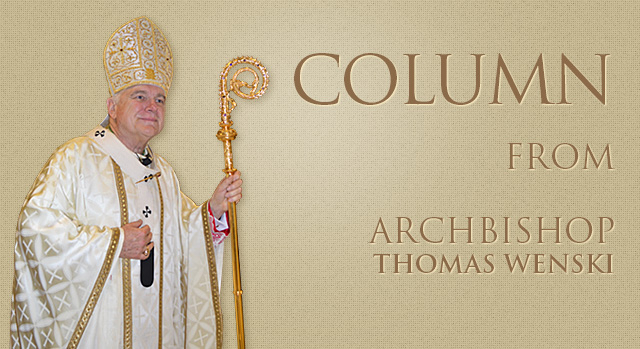By Archbishop Thomas Wenski - The Archdiocese of Miami
As Catholics, we do not believe that we are Platonic “ghosts in machines” or Cartesian “substantive minds.” We believe that we are “ensouled bodies” � we have one human nature, made up of a unity of body and soul. Our bodies � and our differentiation into male and female � are not extraneous to ourselves, to our very beings; rather, our body and our sexuality are part of our identity as persons.
For this reason the Church has always affirmed her belief in the resurrection of the body � that, after the final judgment, we will recover in the glory of heaven (or in its opposite) that unity of body and soul that makes up who we are as persons. Just as we speak of a sacrament as an outward or visible sign of an inner or spiritual reality, our bodies “sacramentally” display our souls. In this way, we can speak of the language of the body. Our body language can communicate the deepest sentiments of the human person created by God for love and communion.
As now Pope Emeritus, Benedict XVI, pointed out in his encyclical, Deus Caritas Est, the word “love” is frequently used and misused. Most commonly, it represents what the ancient Greeks called “eros”; that is, the erotic love between a man and a woman. But the Church, from her earliest days, proposed a new vision of self-sacrificial love expressed in the word “agape.” The natural human love (eros) between a man and a woman is a beautiful and sacred thing but it needs discipline and maturity, it needs “agape” lest it lose its true dignity and purpose.
Our modern society certainly has exalted “eros” but at the same time it has also debased the human body and in doing so has impoverished “eros.” Eros, reduced to just “sex,” has become a commodity � a mere “thing” to be bought and sold. The lack of modesty, our complacency with the “soft porn” that has invaded our popular culture, is not a sign of our society’s “being at ease” with the body � as opposed to an older generation’s supposed prudish uptightness. Rather, it is a sign of our society’s contempt for the human body. Many men and women today consider their bodies and their sexuality as purely material � somehow outside of themselves as if they were “extra baggage or an external shell” and thus able to be used and exploited at will.
As the Fathers of the Second Vatican Council reminded us, man can only realize himself through the sincere gift of himself. The Theology of the Body developed by St. John Paul II speaks of the "nuptial meaning” of the body; for the human body, constituted male or female, reveals man and woman's call to become a gift for one another, a gift fully realized in their "one flesh" union.
The body also has a "generative meaning" that (God willing) brings a "third" into the world through their communion. In this way, marriage constitutes a "primordial sacrament" understood as a sign that truly communicates the mystery of God's Trinitarian life and love to husband and wife � and through them � to their children, and through the family to the whole world.
For this reason, adultery and cohabitation without marriage, one-night stands and so called same-sex unions, while certainly described by some as “erotic,” are in themselves incompatible to our true vocation to love.
These expressions of a fraudulent “body language” are not worthy of the dignity of man created male and female in the image and likeness of God. A fraudulent body language only “communicates” counterfeits of true love. To be authentic, our “body language” must reflect the truth about human nature as created by God. Only manifestations of self-giving that correspond to that truth will tend to that communion of persons to which humanity is directed.

